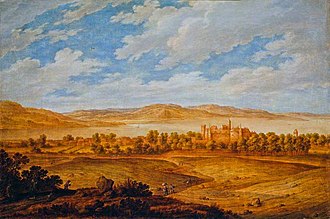In a fitting contribution to the East Lothian Archaeology and Local History Fortnight, three of four Port Seton metal detectorists, who are also keen amateur historians and archaeologists, served up a very entertaining and informative presentation of their work on the ‘lost’ Seton Palace. The team name came into being when, after following up permission to do some metal detecting in the grounds of Seton Castle, the four locals discovered rather more than they expected and, with further permission from the owner were given a short time to carry out a ‘dig’ on the soon to be re-laid front lawn. They chose the name Seton Archaeological Society (SAS, of course!).
Gordon Neil summarised the fascinating and often unfortunate history of the powerful and influential Seton family. The Setons were prominent in Scottish political affairs from 12th until the 18th century. Sir Christopher Seton attended Robert Bruce’s coronation at Scone in 1306 but, following the Battle of Methven, he was captured by the English and, of course, brutally executed in London. His brother Sir Alexander Seton was a signatory to the Declaration of Arbroath. Later he was governor of Berwick when it surrendered to the English in 1333. In the course of the wars with England, Sir Alexander lost 3 sons. His grandson Willian was created the first Lord Seton in 1371. The 5th Lord Seton died at Flodden with James IV. George, the 7th Lord Seton, supported Mary Queen of Scots becoming Privy Councillor and Master of the Household. The queen was a frequent visitor to Seton Palace. On her last visit the marriage contract between Mary and Bothwell was. The Setons’ power continued into the reign of James VI when Alexander Seton was made Lord President of the Court of Session and then later became Chancellor of Scotland. Seton Palace remained the family seat until the Jacobite rising of 1715 when George Seton, 5th Earl of Winton, a staunch supporter of the failed Jacobite cause, had his palace and estates confiscated. The palace fell into a state of ruin and was demolished in 1789, to be replaced, under new ownership, by a Robert Adam designed mansion using much of the stone from the old palace – essentially the Seton Castle of today. The castle was commissioned by the first owner, Lt Colonel Alexander Mackenzie, and in due course passed to the Earls of Wemyss and March who held it until the early 21st century. It is currently owned by Steven Leach and was put on the market recently, asking offers over £8 million.
Billy Campbell then took the floor to explain the background to the group’s interest. The uneven nature of the old lawn had caught their attention and they wondered if this might have anything to do with the previous structure on the site – Seton Palace. An old illustration of the palace encouraged this view. After a meeting over coffee with Mr Leach, permission to excavate was obtained. This had a restricted timescale because the area was to be levelled with a new topsoil prior to relaying the lawn. They had 6 months starting in the October, for a team who could only work part-time! It did help that Gordon Neil applied for, and got, the job of caretaker.
Frank Chambers then took us through the work from test pits to a much fuller investigation. With the aid of aerial photographs taken from a drone and more traditional ones at ground level we gained a clear understanding of the progress of the work and the structural details uncovered. At all times the team were guided by advice and support from the East Lothian Archaeology Service and professional archaeologists. However, SAS planned the digs and did the work, painstakingly removing tons of earth and rubble to reveal elements of the old palace. In the process they unearthed human remains which introduced a 6 week hiatus while official investigations were made – fortunately showing that the remains were not recent. The skull and some bones, with many artifacts uncovered on site have been placed with the relevant authorities. Of note was a discarded stoneware container found in the bottom of a latrine drain. Did it contain brandy? Was it the hair of the dog after the night before? Speculation, of course, but perhaps we were seeing something of the behaviour of one of the workers.
Work on the site first uncovered wall bases, one of which was excavated back to the foundations of the west turret – one of the turrets of the original palace. Further excavations revealed part of the south wall and the east turret which match old depictions of the palace as it was in its prime. A drain and a latrine (see above), flagstone flooring and door checks were found, together with the hint of a spiral staircase. Inside part of a room behind the west turret amongst the rubble the team found pieces of beautiful plasterwork which would have adorned the ceiling. It was very similar in quality and style to existing plasterwork in Winton House (also property of the Seton family at the time). A prize find for the team was a piece of glass bottle carrying the Seton seal.
At this point, time was up, and the site was covered, levelled and the new lawn made. SAS would now like to excavate the site of the old hamlet of Seton Toun nearby, and hope to gain the necessary permission from the new owners of the castle. Currently they are developing this as a community project.
Peter R
